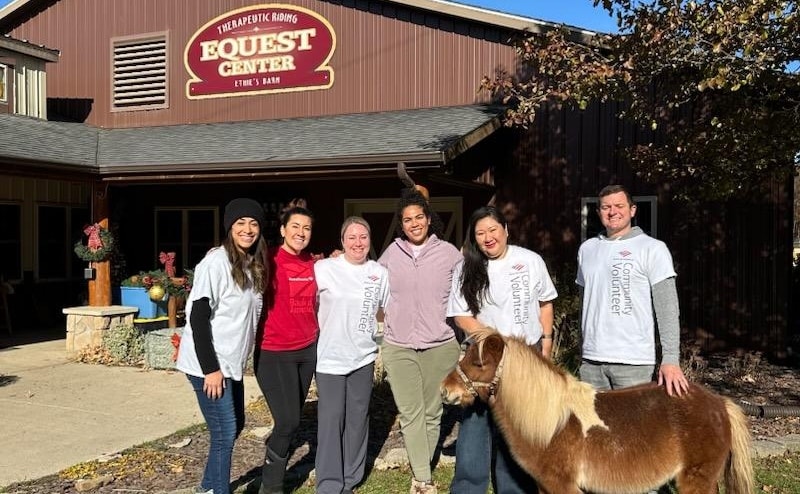West Side Moving Guide
The West Side has survived devastating floods, invasive highway projects, and factory closings. So what could possible be next? How about a housing boom.
Grand Rapids’ West Side has endured more than its share of hard times. But it’s always bounced back.
In 1883, 75 million feet of logs jammed the river at the D. G. H. & M Railroad Bridge. Water flooded the streets. After three weeks, the bridge gave way. A maelstrom of timber and water demolished all other bridges in its path. Property losses totaled $5 million.
Then the “Great Flood of 1904” reached all the way to John Ball Park, displacing 14,000 residents. Fifty factories closed, leaving 8,000 workers unemployed. Damages reached $1.8 million.
The residents—mostly poor immigrants from Poland, Italy, Germany, Ireland, and the Netherlands—were hardy people who had survived war and political upheaval in their native countries. They resolved to survive the floods, too, and rallied the city to build floodwalls along the river’s west bank.
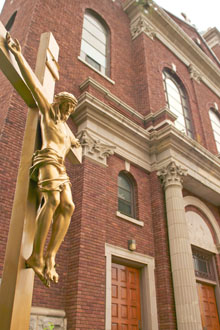 Then came the Great Depression. Food supplies dwindled and hunger hit the city. John Ball Park Zoo butchered its deer and buffalo, and gave the meat to Grand Rapids families.
Then came the Great Depression. Food supplies dwindled and hunger hit the city. John Ball Park Zoo butchered its deer and buffalo, and gave the meat to Grand Rapids families.
In 1958, construction began for US 131 and I-96. The neighborhood lost 1,000 homes to make way for the new highways.
Throughout these trials, the people could always count on the constancy of the gypsum mines. By 1890, 13 separate mine operators employed many west siders. But, in the 1990s, the seemingly inexhaustible supply of gypsum ran out and the mines closed.
Today, the West Side—bounded generally by Leonard Street on the north, John Ball Park on the west, Fulton on the south, and the Grand River to the east—is rallying once again. Three neighborhood associations—John Ball Park Community Association, South West Area Neighbors (SWAN), and West Grand Neighborhood Organization—and four business districts—Stockbridge, West Leonard, West Fulton, and a retail/office/manufacturing corridor along Broadway—keep the neighborhood moving forward.
“I love this city,” said Jane Grischke, a west sider for 11 years. “Once you’ve lived on the west side you don’t ever want to leave it.”
A Spirit of Neighborliness
Grischke and her neighbors ride their bicycles around the neighborhood every night. “We’ve met new people and have maintained strong friendships that way. We feel comfortable, even at dusk. The best thing is knowing your neighbors.”
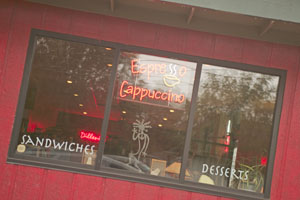 Neighbors don’t always get along, however, and when a problem arose a few years ago, Grischke is proud to report it was resolved quickly and with dignity.
Neighbors don’t always get along, however, and when a problem arose a few years ago, Grischke is proud to report it was resolved quickly and with dignity.
“One neighbor drove the rest of us nuts with their loud music and other things,” Grischke said. “We had a language barrier because they are Hispanic.”
Grischke arranged a meeting at her house with the Neighborhood Watch, planning to report the irritating neighbor. To her surprise, the neighbor showed up. “They had the audacity to come over and apologize!” Grischke said with a laugh. “Since then we have a new respect for each other. The greatest part of our neighborhood is its ability to get along with each other, embrace different ethnic groups and make a good, strong neighborhood out of it.”
A Housing Market Moving Up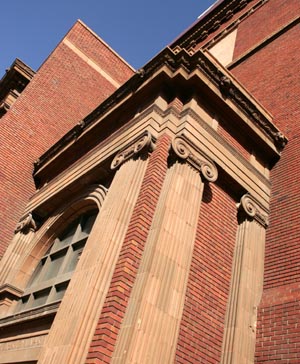 And the neighborhood continues to get stronger and more desirable. The renovation of the 240,000-square-foot former Union High School into Union Square Condos features three tax-free incentives: a Renaissance Zone, a Neighborhood Enterprise Zone, and a Community Reinvestment Zone.
And the neighborhood continues to get stronger and more desirable. The renovation of the 240,000-square-foot former Union High School into Union Square Condos features three tax-free incentives: a Renaissance Zone, a Neighborhood Enterprise Zone, and a Community Reinvestment Zone.
“As far as we know,” said Jon Rooks, owner of Parkland Properties, the marketing agency for Union Square, “it’s the only project in Michigan that offers all three.”
There are 155 condominiums and 25 rooftop penthouses. Starting price for a one-bedroom condo is $95,000. The interiors creatively re-use architectural and functional elements found in the building.
“We took anything that had a school theme and used it,” Rooks said. “We used lockers for closets, we left the chalkboards right where they were in the classrooms, and we left the 100-year-old wood floors. It’s a strong building so we were able to add a pool, Jacuzzi, and penthouses on the roof.”
A few blocks west, another Renaissance Zone provides tax-free living in the former American Seating warehouses that are now American Seating Park. Sixty-seven apartments are located in its Off Broadway complex and 22 luxury apartments in its Clark Place complex. Residents can take advantage of outdoor spaces created especially for them.
 “We have a professionally landscaped courtyard with a fountain,” said Mike Munyon, director of maintenance and security. “There are grills and patio furniture for residents to use, and an outdoor amphitheater where live events are held.”
“We have a professionally landscaped courtyard with a fountain,” said Mike Munyon, director of maintenance and security. “There are grills and patio furniture for residents to use, and an outdoor amphitheater where live events are held.”
Bob Israels, owner of Israels Designs for Living, and his son, David, plan to convert another American Seating building into 26 housing units, including 13 live/work spaces.
The construction of another 52 townhouses in the block bounded by Broadway, Alabama, First, and Second Streets is in the negotiation stage.
“Families, college students, and young professionals live in the Near West Side because it’s convenient to the city,” said Dawn Longcore, realtor for Keller Williams Realty. “Many bungalows and 2-story homes were built between 1890 and 1940. In some cases, two homes share one parcel as part of a Polish tradition: when a child married, the parents built the newlyweds a house on the same lot with the family home.
“There are lots of homes for sale, which means the market is on the move,” Longcore added. “One-third are multi-family units. Properties range from $65,000 for duplexes to $200,000 for larger units. Single family homes range from $55,000 to $150,000.”
A Neighborhood After Your Heart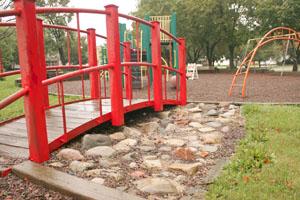 With $532,000 in grant money, the Turner Gateway Project is on its way to beautifying Turner Avenue with new sidewalks, curb bump-outs, pedestrian-friendly lighting, crosswalks, and streetside gardens.
With $532,000 in grant money, the Turner Gateway Project is on its way to beautifying Turner Avenue with new sidewalks, curb bump-outs, pedestrian-friendly lighting, crosswalks, and streetside gardens.
Out of the grant money, $30,000 is earmarked for individual home improvement grants to Turner Gateway Zone residents. Homeowners can apply for up to $3,000 for external repairs and improvements.
“We’ve given away one grant already,” said Andrea Bardelmeier, Turner Gateway Project coordinator. “We hope to give away 10 to 15 more.”
A bleak area where Turner passes under US 131 will get a facelift with two rain gardens totaling 1,600 square feet. The gardens will filter 30 to 80 percent of the pollutants out of the highway rainwater runoff before it reaches the Grand River.
“A rain garden mural will be in the midst of the garden,” Bardelmeier said. Created by local artists Rebecca Kenny and Mary Wisniewski, the mural will depict how the rain garden works.
The new Sibley Elementary School opened its doors this year. Pine Academy, Westwood Middle, John Ball Park Environmental Education Program, St. James Catholic School, West Catholic, Bimaadaziwin, and other schools dot the neighborhood. Grand Valley State University’s Pew Campus anchors the southeast corner.
 Lincoln Park, John Ball Park, Ah-Nab-Awen Park, and the GVSU campus provide plenty of green spaces. The Riverwalk lines both riverbanks where walkers, cyclists, runners, skateboarders, and rollerbladers can cross one of two pedestrian bridges to reach downtown in a matter of minutes. Less adventurous types might prefer to drop a fishing line over the railing.
Lincoln Park, John Ball Park, Ah-Nab-Awen Park, and the GVSU campus provide plenty of green spaces. The Riverwalk lines both riverbanks where walkers, cyclists, runners, skateboarders, and rollerbladers can cross one of two pedestrian bridges to reach downtown in a matter of minutes. Less adventurous types might prefer to drop a fishing line over the railing.
As a predominantly Catholic neighborhood, Catholic churches are within close proximity of one another: St. James, Sacred Heart, Ss. Peter and Paul, St. Mary, and Michigan’s only Roman Catholic Basilica, St. Adalbert Basilica. Other churches are just a stone’s throw from anywhere in the neighborhood, including Fellowship Chapel, West Leonard Christian Reformed, Trinity Reformed, and 7th Reformed.
The West Side exudes a comfortable feeling that keeps its residents living there decade after decade. Or, as Jane Grischke explains, “Once it’s in your heart it stays there forever.”

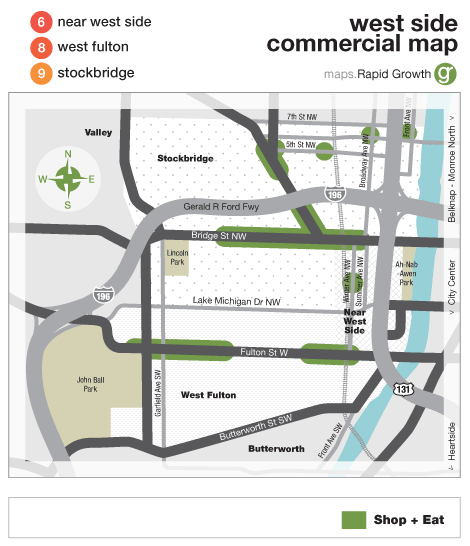
Directions to the West Side
From the North:
Take US-131 South toward Grand Rapids and take Exit 85B toward Pearl St/Downtown. Stay straight to go onto Mt. Vernon Ave NW and turn right onto Pearl St NW. Pearl St NW becomes Lake Michigan Dr. NW. Arrive in the West Side.
From the East:
Take I-96 West toward Grand Rapids and then take I-196 West toward Downtown Grand Rapids/Holland. Merge onto US-131 South via Exit 77B on the Left toward Kalamazoo. Continue to Exit 85B toward Pearl St/Downtown. Stay straight to go onto Mt. Vernon Ave NW and turn right onto Pearl St NW. Pearl St NW becomes Lake Michigan Dr. NW. Arrive in the West Side.
From the South:
Take US-131 North toward Grand Rapids. Take Exit 85B for Pearl St and turn left onto Pearl St NW. Pearl St NW becomes Lake Michigan Dr. NW. Arrive in the West Side.
From the West:
Take I-196 East toward Grand Rapids and merge onto US-121 South via Exit 77B toward Kalamazoo. Take Exit 85B toward Pearl St/Downtown. Stay straight to go onto Mt. Vernon Ave NW and turn right onto Pearl St NW. Pearl St NW becomes Lake Michigan Dr. NW. Arrive in the West Side.
Take I-96 East toward Grand Rapids and merge onto US-131 South via Exit 31A toward Grand Rapids/Kalamazoo. Take Exit 85B toward Pearl St/Downtown. Stay straight to go onto Mt. Vernon Ave NW and turn right onto Pearl St NW. Pearl St NW becomes Lake Michigan Dr. NW. Arrive in the West Side.
Photographs by Brian Kelly – All Rights Reserved
Images:
American Seating Park
Exterior – Sacred Heart Catholic Church
Dillenbeck’s Coffee House
Union Square Condominium project
Ampitheater – American Seating Park
Lincoln Park playground
Sacred Heart of Jesus School

